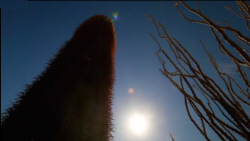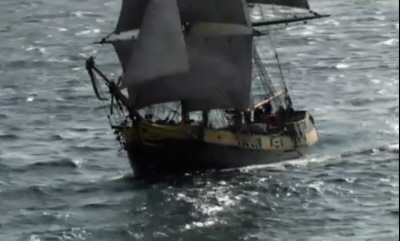The Trade Winds
The deserts they originate in.

Sonoran Cactus
This is the Sonoran Desert in the American state of Arizona. It's about 30 degrees north of the equator. Out here in the summer, it can reach 50 degrees centigrade, just horribly hot, but, now, the summer's long gone and it's actually quite cool here today.
And what that tells us is that it's not heat that defines a desert. It's lack of water. Yearly rainfall can be as low as eight centimetres. The reason it doesn't rain much is that the air here has left much of it's moisture behind at the equator. The Sonoran desert is only here because the Coriolis effect deflects the winds that began at the equator. But it's not just the Sonoran desert where this happens. The same effect helps create deserts at this latitude all around the world.
There's the Thar desert in India, the Arabian desert and, of course the Sahara. They're all created by falling dry air that originated close to the equator.
Here we can really see the influence of the Earth's spin. This pattern of wet rainforest at the equator and dry deserts here is created by a giant system of winds.
Even this is not the end of the cycle. The air that reaches the ground in the desert belt now heads back to the equator, drawn by the low pressure zone at the hottest part of the planet. And as it travels back to the equator, it's subject to the Coriolis effect, so, once again, it bends to the right. This creates very regular and reliable surface winds that blow from the northeast to the southwest - the trade winds.
And that was used by the early human explorers and by traders for centuries because it's much easier to travel if you're moving with the wind.

Exploring the High Seas, with the Trade Winds
From the 15th century onwards, European sailors increasingly exploited the trade winds. They played a central role in the colonisation of the Americas and the establishment of empires around the world.
When the trade winds arrive back at the equator, it closes the circle. The resulting pattern of wind is called a circulation cell. But this circulation cell at the equator isn't the only one. The pattern repeats so that in total, there are 3 circulation cells in each hemisphere, making six. In each cell, air rises and is then bent by the Coriolis effect until it cools, sinks and returns to the surface.
The ground is about 3,000 metres below me. As I fall, I'm travelling with the air that left the equator, because it too is now falling towards the ground. It is so different to the rainforest where the air came from.
She's landed in a desert.
